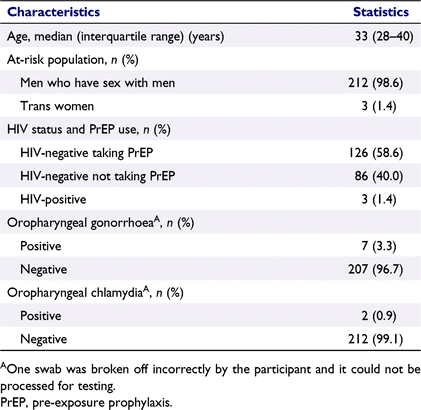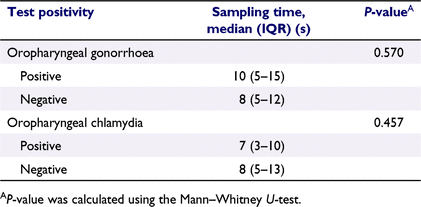Sampling time for self-taking an oropharyngeal swab for gonorrhoea and chlamydia testing
Eric P. F. Chow A B C * , Christopher K. Fairley
A B C * , Christopher K. Fairley  A B , Kate Maddaford
A B , Kate Maddaford  A , Tina Schmidt A , Andrew Buchanan A , Warittha Tieosapjaroen A B , Gerald Tataro A and Tiffany R. Phillips
A , Tina Schmidt A , Andrew Buchanan A , Warittha Tieosapjaroen A B , Gerald Tataro A and Tiffany R. Phillips  A B
A B
A Melbourne Sexual Health Centre, Alfred Health, Melbourne, Vic. 3053, Australia.
B Central Clinical School, Faculty of Medicine, Nursing and Health Sciences, Monash University, Melbourne, Vic. 3004, Australia.
C Centre for Epidemiology and Biostatistics, Melbourne School of Population and Global Health, The University of Melbourne, Melbourne, Vic. 3053, Australia.
Sexual Health 19(2) 148-150 https://doi.org/10.1071/SH22034
Submitted: 14 February 2022 Accepted: 1 March 2022 Published: 28 April 2022
© 2022 The Author(s) (or their employer(s)). Published by CSIRO Publishing
Abstract
Self-taking oropharyngeal swabs for sexually transmitted infections such as gonorrhoea and chlamydia has become more common during the COVID-19 pandemic to minimise the risk to healthcare workers. However, there have been no standardised guidelines on sampling time for taking an oropharyngeal swab for gonorrhoea and chlamydia testing. We recruited 215 participants at the Melbourne Sexual Health Centre, Australia, between November 2021 and January 2022. We asked participants to report the time they spent on self-taking the oropharyngeal swab. The median self-taking sampling time was 8 s (IQR = 5–12), and the time did not differ between oropharyngeal gonorrhoea positivity (P = 0.570) and oropharyngeal chlamydia positivity (P = 0.457).
Keywords: Chlamydia trachomatis, Neisseria gonorrhoeae, pharyngeal, screening, self-collected, sexually transmitted diseases, sexually transmitted infection, throat.
Rises in oropharyngeal gonorrhoea and chlamydia have been observed in at-risk populations such as gay, bisexual, and other men who have sex with men (MSM) and sex workers in many countries.1,2 A correct and accurate sampling method is important for testing. However, there have been no standardised guidelines or recommendations on sampling time for taking an oropharyngeal swab for gonorrhoea and chlamydia testing. In 2021, Stuart and colleagues found that UK sexual health clinicians spent on average 4.6 s taking oropharyngeal swabs for gonorrhoea culture.3 This sampling time was estimated by clinicians, and it may vary between patients. Nucleic acid amplification test (NAAT) has a higher sensitivity than culture for gonorrhoea detection; however, there have been no studies examining the sampling time for taking oropharyngeal swabs for gonorrhoea detected using NAAT.
To minimise the risk of SARS-CoV-2 to healthcare workers during the COVID-19 pandemic, the Melbourne Sexual Health Centre (MSHC) changed from clinician-collected to self-taking oropharyngeal swab in March 2020.4 We aimed to determine the sampling time for self-taking oropharyngeal swabs for gonorrhoea and chlamydia testing.
Between 9 November 2021 and 18 January 2022, clients who attended MSHC, who were aged ≥18 years and were tested for oropharyngeal STI, were invited to participate in a study that asked them to record the amount of time they spent on self-taking one oropharyngeal swab for gonorrhoea and chlamydia testing. We also asked the participants how they recorded the time: (1) using a smartphone; (2) self-counting; or (3) other methods. An illustrated instruction on how to take an oropharyngeal swab was placed in the bathroom but there was no recommended sampling time included in the instructions.4 All oropharyngeal swabs were tested for both gonorrhoea and chlamydia using NAAT. This study was approved by the Alfred Hospital Ethics Committee (386/20).
There were 215 participants recruited in the study and the characteristics are presented in Table 1. The sampling time ranged from 1 to 123 s, with a median of 8 s (IQR = 5–12). Of the 212 participants who answered the question on how they recorded the sampling time, most used self-counting methods (53.3%; n = 113), followed by smartphone (26.9%; n = 57) and then other methods such as guessing or swabbing until it caused a gag reflex (19.8%; n = 42). However, younger participants tended to use a smartphone and older participants tended to use another method (P < 0.001; Supplementary Table S1). There was a significant difference in sampling time across the three methods (P < 0.001; Fig. 1); the median time was 13 s (IQR = 10–26) for smartphone, 6 s (IQR = 5–10) for self-counting and 5 s (IQR = 3–10) for other methods.

|
The test positivity for oropharyngeal gonorrhoea was 3.3% (7/214) and oropharyngeal chlamydia was 0.9% (2/214). The median sampling time did not differ between oropharyngeal gonorrhoea positive test results vs negative test results (10 s vs 8 s; P = 0.570); and between oropharyngeal chlamydia positive test results vs negative test results (7 s vs 8 s; P = 0.457; Table 2). The small number of oropharyngeal gonorrhoea cases might be due to the changes in sexual practices during the COVID-19 pandemic5 and it may not have enough power to detect the differences.

|
There have been no standardised guidelines on sampling time for taking an oropharyngeal swab for gonorrhoea and chlamydia testing. Our findings suggest that most individuals spent 8 s on sampling the oropharynx. Some participants swabbed until having a gag reflex, but a past study has shown that there was no association between having a gag reflex and gonorrhoea test positivity using NAAT.6 Self-taking nasopharyngeal swabs have become more common since the COVID-19 pandemic and some guidelines recommended swabbing for 10–15 s for COVID-19 testing.7,8 Self-counting or guessing may not be accurate and it may not be practical to use a smartphone to count; therefore, recommending the number of rotations at tonsils and the posterior pharyngeal wall (e.g. five rotations for COVID-19 sampling) may be easier or more practical for self-taking swabs.8
Supplementary material
Supplementary material is available online.
Data availability
All data relevant to the study are included in the article.
Conflicts of interest
CKF and EPFC are Editors of Sexual Health, but they were blinded from the peer-review process for this paper. All other authors declare no conflicts of interest.
Declaration of funding
This study was funded by an Australian National Health and Medical Research Council (NHMRC) Emerging Leadership Investigator Grant (GNT1172873). EPFC is supported by an NHMRC Emerging Leadership Investigator Grant (GNT1172873). CKF is supported by an Australian NHMRC Leadership Investigator Grant (GNT1172900).
Author contributions
EPFC, TRP and CKF conceived the study. EPFC and TRP designed the study and oversaw the study. EPFC performed data analyses and wrote the first draft of the manuscript. KM, TS, AB and GT were involved in study recruitment. KM and WT were involved in data entry. WT assisted with literature search. All authors were involved in data interpretation, revising the manuscript for important intellectual content and approved the final version. The corresponding author had full access to all the data in the study and had final responsibility for the decision to submit for publication.
Acknowledgements
We gratefully acknowledge our IT expert Afrizal Afrizal from the Melbourne Sexual Health Centre for his assistance in data extraction. We thank Surbhi Bird, Noriko Doktorovich and Caroline Cittarelli at the Melbourne Sexual Health Centre for their assistance in recruitment.
References
[1] Callander D, Guy R, Fairley CK, McManus H, Prestage G, Chow EPF, et al. Gonorrhoea gone wild: rising incidence of gonorrhoea and associated risk factors among gay and bisexual men attending Australian sexual health clinics. Sex Health 2019; 16 457–63.| Gonorrhoea gone wild: rising incidence of gonorrhoea and associated risk factors among gay and bisexual men attending Australian sexual health clinics.Crossref | GoogleScholarGoogle Scholar | 30409244PubMed |
[2] Callander D, McManus H, Guy R, Hellard M, O’Connor CC, Fairley CK, et al. Rising chlamydia and gonorrhoea incidence and associated risk factors among female sex workers in Australia: a retrospective cohort study. Sex Transm Dis 2018; 45 199–206.
| Rising chlamydia and gonorrhoea incidence and associated risk factors among female sex workers in Australia: a retrospective cohort study.Crossref | GoogleScholarGoogle Scholar | 29420449PubMed |
[3] Stuart S, Richardson D, Iwuji C, Soni S. How long should clinicians spend sampling the pharynx for gonorrhoea culture specimens? Sex Health 2022; 19 74–75.
| How long should clinicians spend sampling the pharynx for gonorrhoea culture specimens?Crossref | GoogleScholarGoogle Scholar | 34969437PubMed |
[4] Chow EPF, Bradshaw CS, Williamson DA, Hall S, Chen MY, Phillips TR, et al. Changing from clinician-collected to self-collected throat swabs for oropharyngeal gonorrhoea and chlamydia screening among men who have sex with men. J Clin Microbiol 2020; 58
| Changing from clinician-collected to self-collected throat swabs for oropharyngeal gonorrhoea and chlamydia screening among men who have sex with men.Crossref | GoogleScholarGoogle Scholar | 32611792PubMed |
[5] Chow EPF, Hocking JS, Ong JJ, Phillips TR, Schmidt T, Buchanan A, et al. Brief Report: Changes in PrEP use, sexual practice, and use of face mask during sex among MSM during the second wave of COVID-19 in Melbourne, Australia. J Acquir Immune Defic Syndr 2021; 86 153–6.
| Brief Report: Changes in PrEP use, sexual practice, and use of face mask during sex among MSM during the second wave of COVID-19 in Melbourne, Australia.Crossref | GoogleScholarGoogle Scholar | 33433122PubMed |
[6] Yang TZT, Chen MY, Read TRH, Needleman R, Bradshaw CS, Fortune R, et al. Sampling technique and detection rates of oropharyngeal and anorectal gonorrhoea using nucleic acid amplification tests in men who have sex with men. Sex Transm Infect 2018; 94 287–92.
| Sampling technique and detection rates of oropharyngeal and anorectal gonorrhoea using nucleic acid amplification tests in men who have sex with men.Crossref | GoogleScholarGoogle Scholar | 29133523PubMed |
[7] Coden E, Russo F, Arosio AD, Castelnuovo P, Karligkiotis A, Volpi L. Optimum naso-oropharyngeal swab procedure for COVID-19: step-by-step preparation and technical hints. Laryngoscope 2020; 130 2564–7.
| Optimum naso-oropharyngeal swab procedure for COVID-19: step-by-step preparation and technical hints.Crossref | GoogleScholarGoogle Scholar | 32716074PubMed |
[8] Centers for Disease Control and Prevention. How to collect an anterior nasal swab specimen for COVID-19 testing. Atlanta, GA, USA: Centers for Disease Control and Prevention; 2021. Available at https://www.cdc.gov/coronavirus/2019-ncov/testing/How-To-Collect-Anterior-Nasal-Specimen-for-COVID-19.pdf


